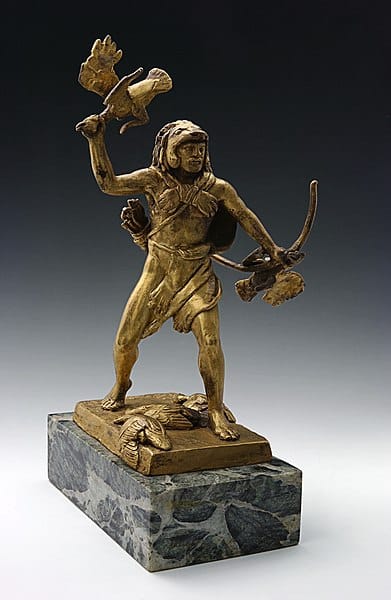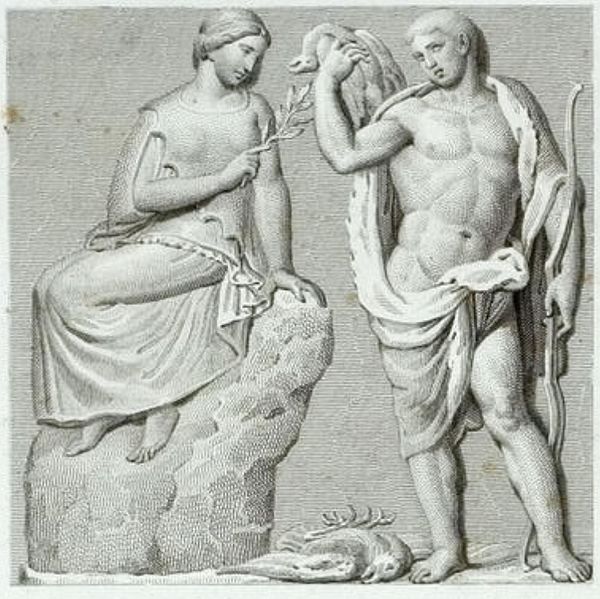The Stymphalian Birds are usually depicted as menacing and metallic-feathered avian creatures. They hold a unique place among all the monsters in Greek mythology. These birds, known for their destructive nature and association with the hero Heracles, The Strongest Hero of Ancient Greece, are more than just creatures of flight; they are symbols of challenges faced and overcome. In the vast tapestry of Greek myths, they stand out not just for their fearsome nature but also for the pivotal role they played in one of Heracles’ renowned Twelve Labors.
Stymphalian Birds Key Facts
| Keyword | Fact |
| Origin | Stymphalian Lake, Arcadia |
| Creator | None |
| Defeated by | Heracles |
| Habitat | Stymphalian Lake and surrounding regions |
| Other names | None |
| Roman name | Stymphalides |
| Associated with | Heracles’ Sixth Labor |
| Symbols | Metallic feathers, sharp beaks, and bronze claws |
Name and Etymology
The name “Stymphalian” is derived from the Stymphalian Lake in Arcadia, where these birds were said to reside. In Roman myths, they are referred to as “Stymphalian, The Winged Menace of Heracles.” While the etymology primarily points to their habitat, it also underscores the terror they brought to the region. The name itself became synonymous with menace and challenge, especially in the context of Heracles’ labors.
The Roman adaptation of these birds, while retaining most of their characteristics, often emphasized their metallic nature, with some texts referring to them as “bronze birds.” This metallic association not only highlighted their invulnerability but also their role as instruments of destruction.
In various myths and texts, the Stymphalian Birds are sometimes simply referred to as the “birds of Stymphalus” or “the winged menace of Arcadia,” emphasizing their close association with the region and the terror they instilled.

Stymphalian Birds Origin and Creation
The Stymphalian Birds were not creatures born of divine intervention or a curse but were natural inhabitants of the Stymphalian Lake in Arcadia. This lake, surrounded by dense forests and marshlands, provided the perfect sanctuary for these birds, allowing them to thrive and multiply. Their origin is somewhat shrouded in mystery, with some ancient texts suggesting that they might have been offspring of monstrous birds that once terrorized different parts of the ancient world.
What set the Stymphalian Birds apart from other avian creatures were their metallic feathers, which they could launch at their prey, and their insatiable appetite for human flesh. Over time, their numbers grew, and so did their threat, turning the once serene Stymphalian Lake region into a place of dread.
The birds’ presence in Arcadia was not just a natural occurrence but was seen as a challenge that needed to be addressed, leading to their eventual encounter with the hero Heracles.
Stymphalian Birds Encounters and Conflicts
The Stymphalian Birds, with their increasing numbers and destructive nature, posed a significant threat to the inhabitants of Arcadia and the surrounding regions. Their metallic feathers, which they could shoot at their prey, combined with their taste for human flesh, made them a menace that couldn’t be ignored.
Heracles and the Stymphalian Birds
The most famous encounter with the Stymphalian Birds is undoubtedly their confrontation with Heracles. Tasked with driving them away as his sixth labor, Heracles faced a unique challenge. The marshy terrain around the Stymphalian Lake made it difficult to approach the birds directly. With the help of Athena, the goddess of wisdom, who provided him with bronze castanets, Heracles managed to startle the birds, causing them to take flight. Once airborne, Heracles shot them down with his arrows, ridding Arcadia of the winged menace.
This labor was not just a test of Heracles’ strength but also his wit and strategy. The Stymphalian Birds, with their numbers and abilities, were formidable opponents, but Heracles’ clever approach ensured his victory, further cementing his status as one of the greatest heroes of Greek mythology.
Depiction And Characteristics
The Stymphalian Birds, while rooted in mythology, have been depicted in various forms throughout history, each representation capturing their fearsome nature and the terror they instilled in the people of Arcadia.
The Stymphalian Birds are often described as large, predatory birds with sharp beaks and talons. But what truly sets them apart from other avian creatures in Greek mythology is their metallic feathers. These feathers, often described as bronze or some other metal, were not just for show; they were weapons. The birds could launch these feathers like arrows, making them deadly from a distance. Their eyes, often depicted as red or glowing, added to their menacing appearance, making them a sight of dread for anyone who encountered them.
In many depictions, especially in ancient pottery and sculptures, the Stymphalian Birds are shown mid-flight, with their metallic feathers prominently displayed, emphasizing their role as airborne threats. Their size varied across depictions, with some showing them as slightly larger than average birds, while others portrayed them as massive creatures, dwarfing humans and other animals.
Stymphalian Birds Nature and Behavior
The nature of the Stymphalian Birds was one of aggression and predation. They were not just content with hunting smaller animals; they had developed a taste for human flesh. This made them a significant threat to the inhabitants of the regions they occupied. Their behavior was often described as erratic and unpredictable, with sudden attacks on travelers and even entire settlements.
Their aggressive nature was further amplified by their numbers. They were not solitary creatures; often moving and attacking in flocks, overwhelming their prey with sheer numbers and coordinated assaults.
Stymphalian Birds Abilities
Beyond their metallic feathers, which they launched with deadly precision, they possessed other abilities that made them formidable opponents. Their sharp talons and beaks could tear through armor and flesh with ease. Their keen senses, especially their sight, allowed them to spot potential prey from great distances.
Furthermore, their ability to move in coordinated flocks added a strategic element to their attacks. They could surround and trap their prey, making escape almost impossible. This combination of physical abilities and strategic behavior made them one of the more challenging opponents Heracles had to face.
Stymphalian Birds Symbols or Associations
The Stymphalian Birds are primarily known for their association with Heracles’ sixth labor. However, they have also come to symbolize overwhelming challenges and the need for wit and strategy in overcoming them. Their metallic feathers, often seen as a symbol of their invulnerability and deadly nature, have been used in various artworks. The focus of which are typically representations of insurmountable odds.
In some interpretations, the Stymphalian Birds are also associated with the destructive aspects of nature. Their origin from the Stymphalian Lake, a serene place turned into a site of terror due to their presence. This furtermore served as a reminder of nature’s unpredictable and sometimes destructive side.
Myths about Stymphalian Birds
The myth of the Stymphalian Birds is intrinsically tied to Heracles and his Twelve Labors. Tasked by King Eurystheus to rid the Stymphalian Lake of these birds, Heracles faced a unique challenge. The marshy and dense terrain around the lake made a direct approach difficult. However, with assistance from Athena, providing him with loud bronze castanets, Heracles successfully scared the birds into the air. Once they were airborne, he used his bow and arrow to shoot them down. Finally ridding the region of the menace.
This labor was not just about physical strength but also highlighted Heracles’ ability to strategize. The Stymphalian Birds, with their numbers and the advantage of the terrain, seemed like an insurmountable challenge. Yet, with wit and the right tools, Heracles overcame them, further solidifying his legendary status.
The story of the Stymphalian Birds serves as a reminder of the challenges the ancient Greeks believed their heroes faced. It wasn’t always about brute strength; sometimes, wit, strategy, and a little divine intervention were needed to overcome the odds.

Representations Of Stymphalian Birds In Art
Throughout history, the Stymphalian Birds have captured the imagination of artists and sculptors. Their unique appearance, combined with the mythological significance, made them a popular subject in ancient Greek art. Vases and pottery from ancient Greece often depict the moment Heracles confronts these birds. Emphasizing the challenge and the hero’s determination.
In later periods, especially during the Renaissance, the Stymphalian Birds were portrayed in paintings. Often as a part of larger works depicting the labors of Heracles. These depictions often focused on the birds’ metallic nature, with artists using shades of bronze to highlight their feathers.
Mentions in Ancient Texts
The Stymphalian Birds, given their association with one of Heracles’ most famous labors, find mention in several ancient texts. One of the most notable references is in Apollodorus’ “Bibliotheca,” where the challenge posed by the birds and Heracles’ strategy to overcome them is detailed.
A quote from the text reads: “He was not able to hunt the birds down one by one because of the great number of the lake, so he frightened them with the noise of a rattle given him by Athena and shot them down with arrows as they flew up in fear.”
Frequently Asked Questions
The Stymphalian Birds were metallic-feathered, predatory birds from Greek mythology. They were known for their aggressive nature and association with Heracles’ sixth labor.
They resided around the Stymphalian Lake in Arcadia, turning the region into a place of dread due to their presence.
With the help of Athena, who provided him with bronze castanets, Heracles scared the birds into the air. He could shoot them down with his arrows.
They symbolize overwhelming challenges and the combination of wit, strategy, and strength required to overcome such challenges.
The Stymphalian Birds are mythical creatures. They might be based on real birds or exaggerated accounts of actual species, they remain a product of Greek mythology.
Their metallic feathers, often described as bronze, were one of their defining characteristics. Moreover, they served both as a weapon and a symbol of their invulnerability.
Featured Image Credit: Kunsthistorisches Museum, Public domain, via Wikimedia Commons
